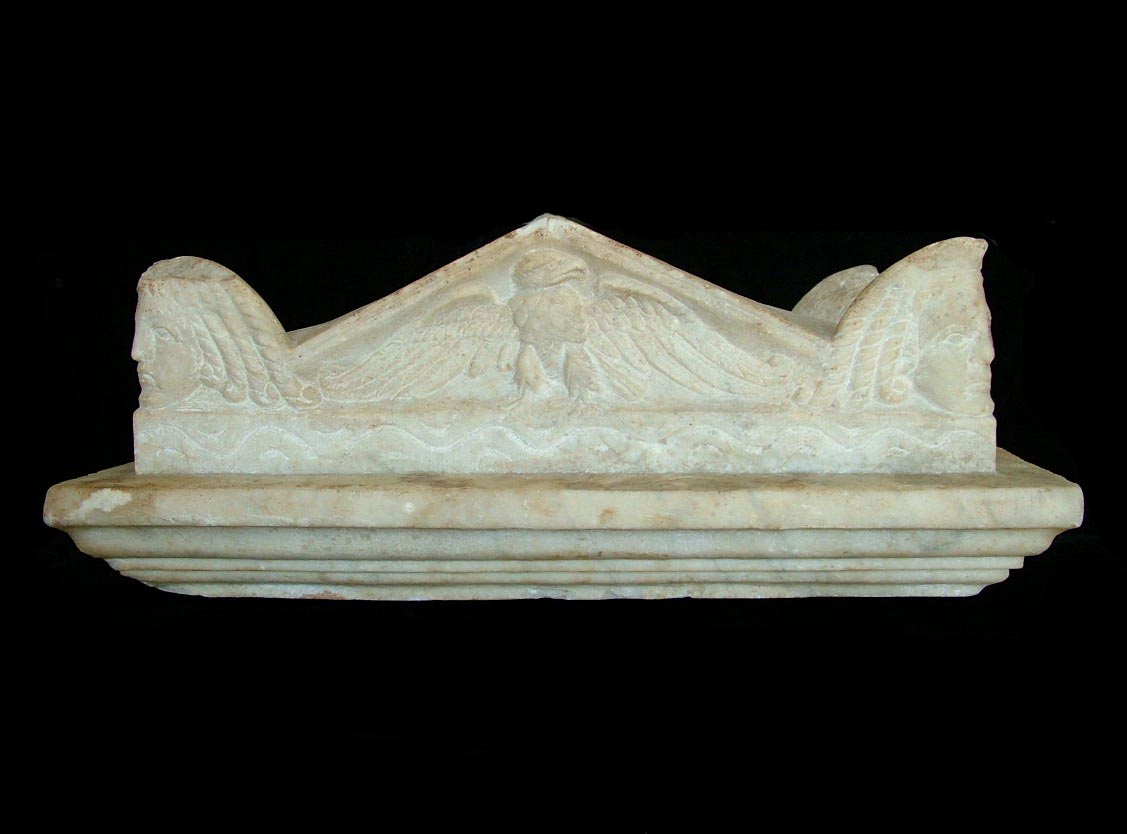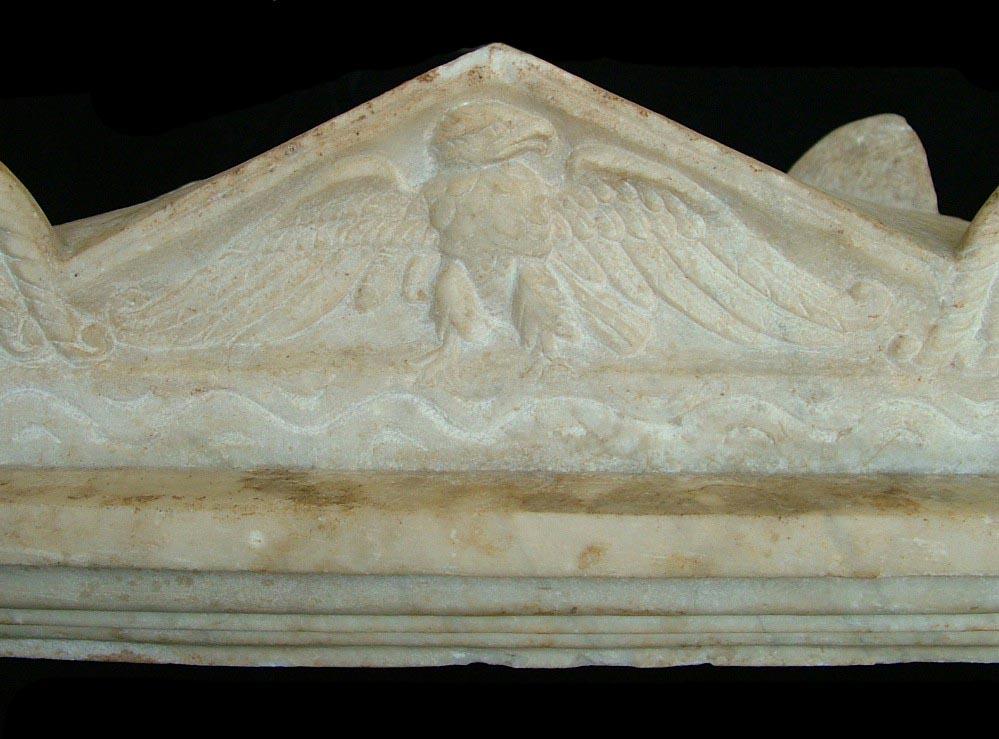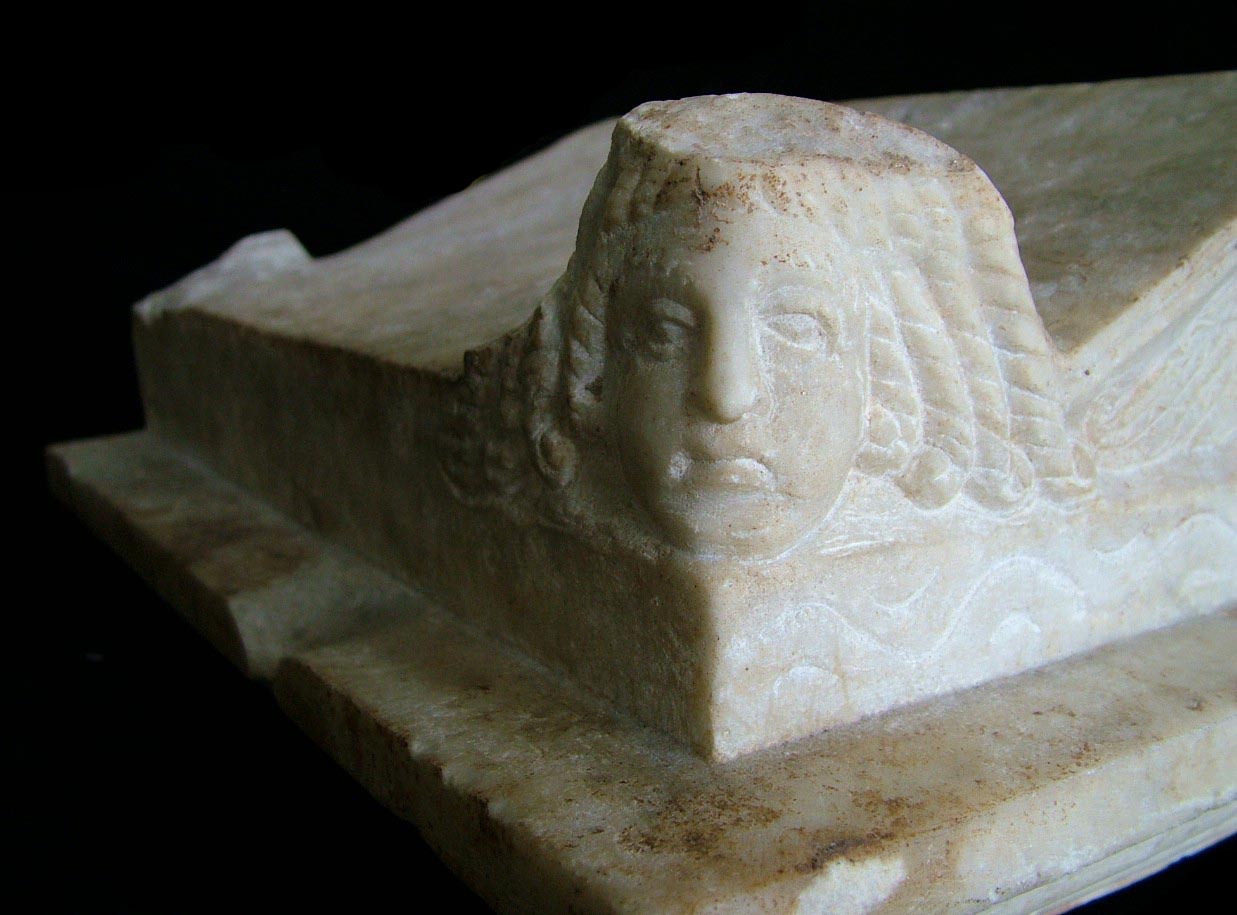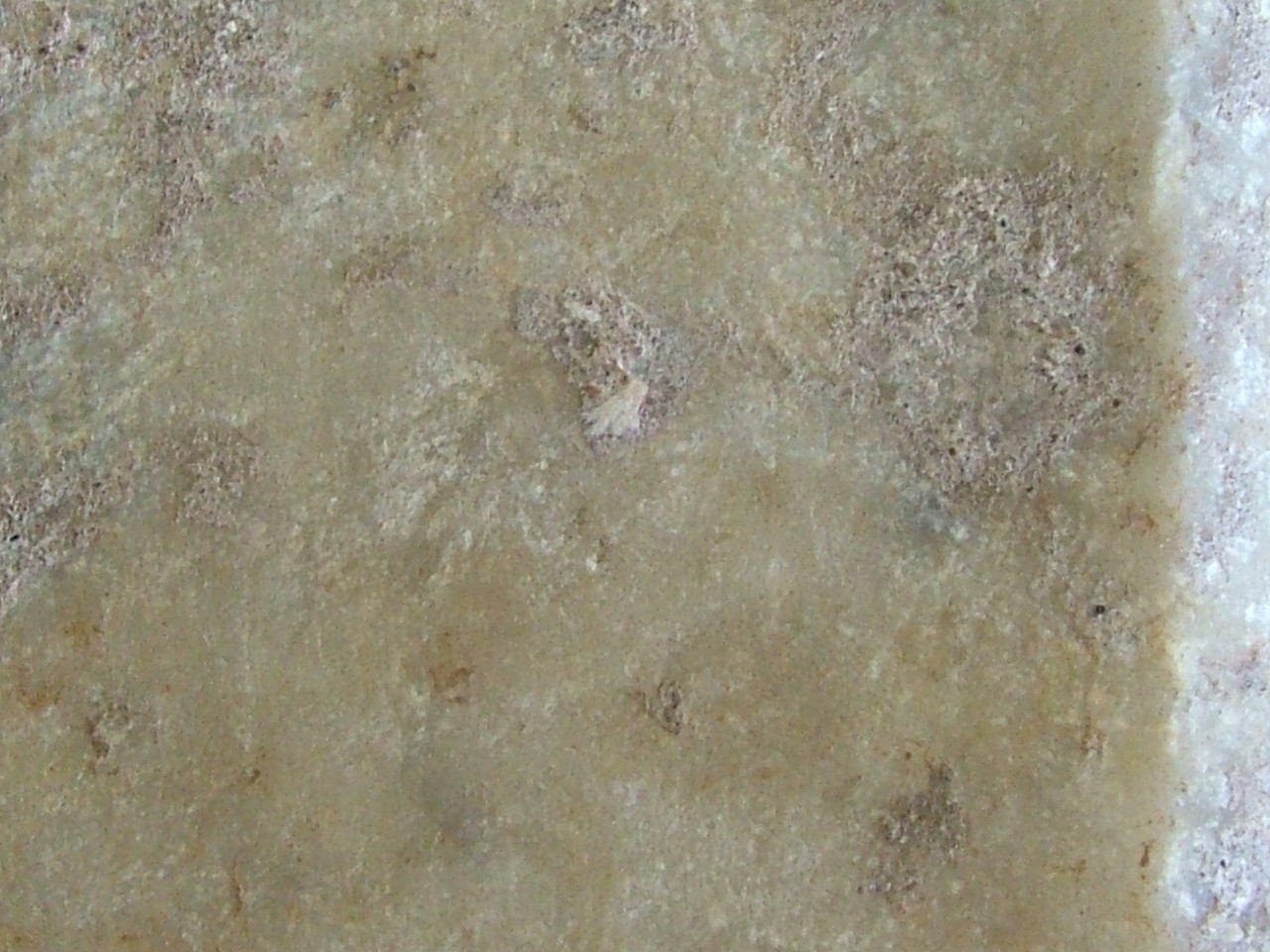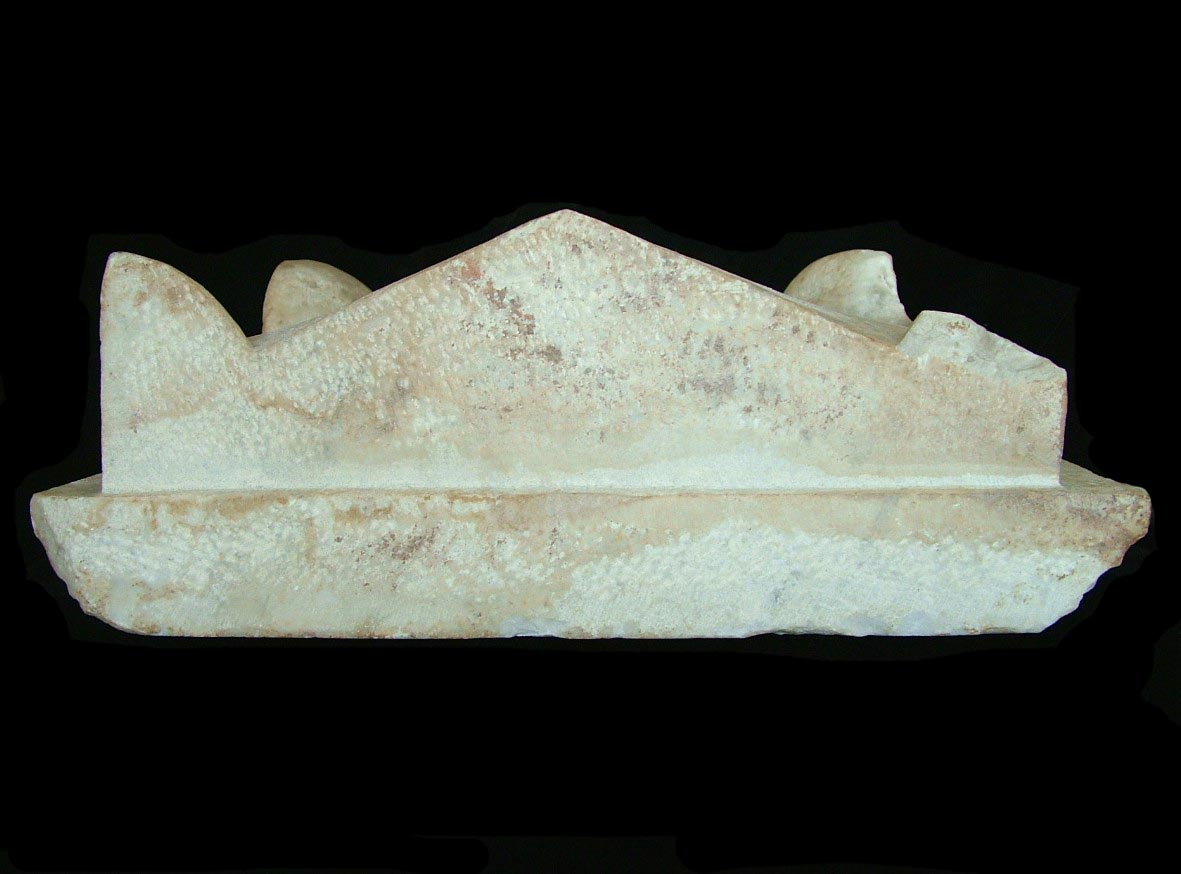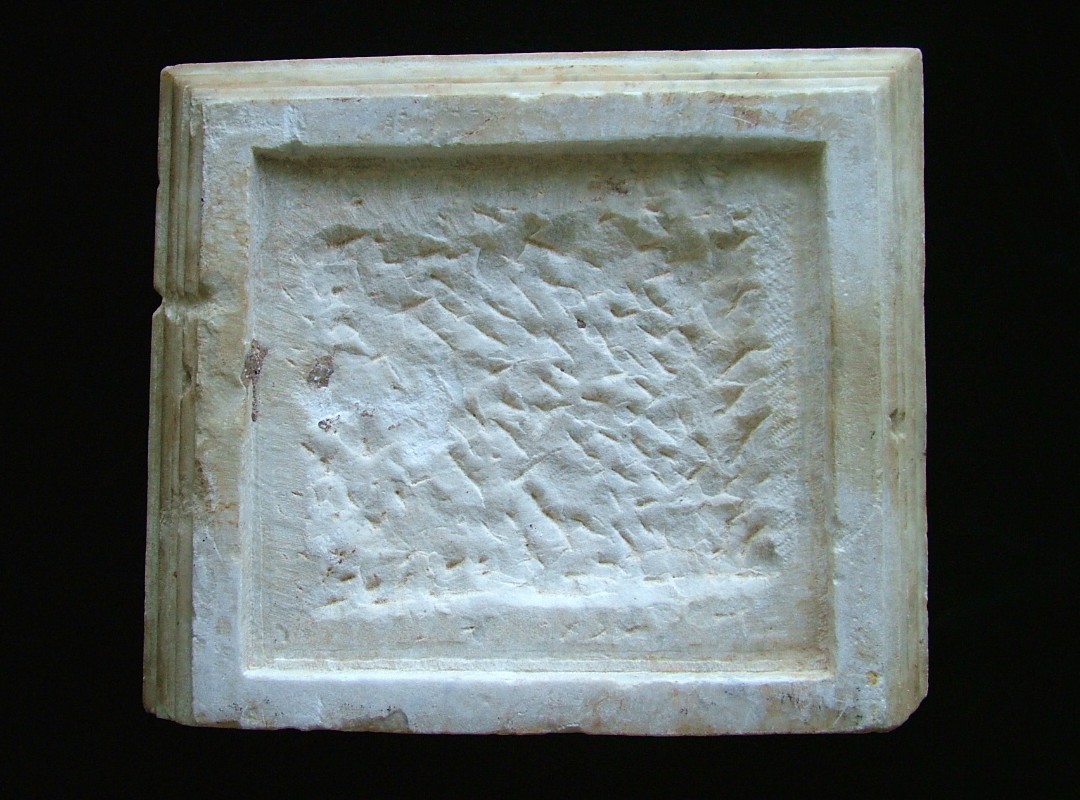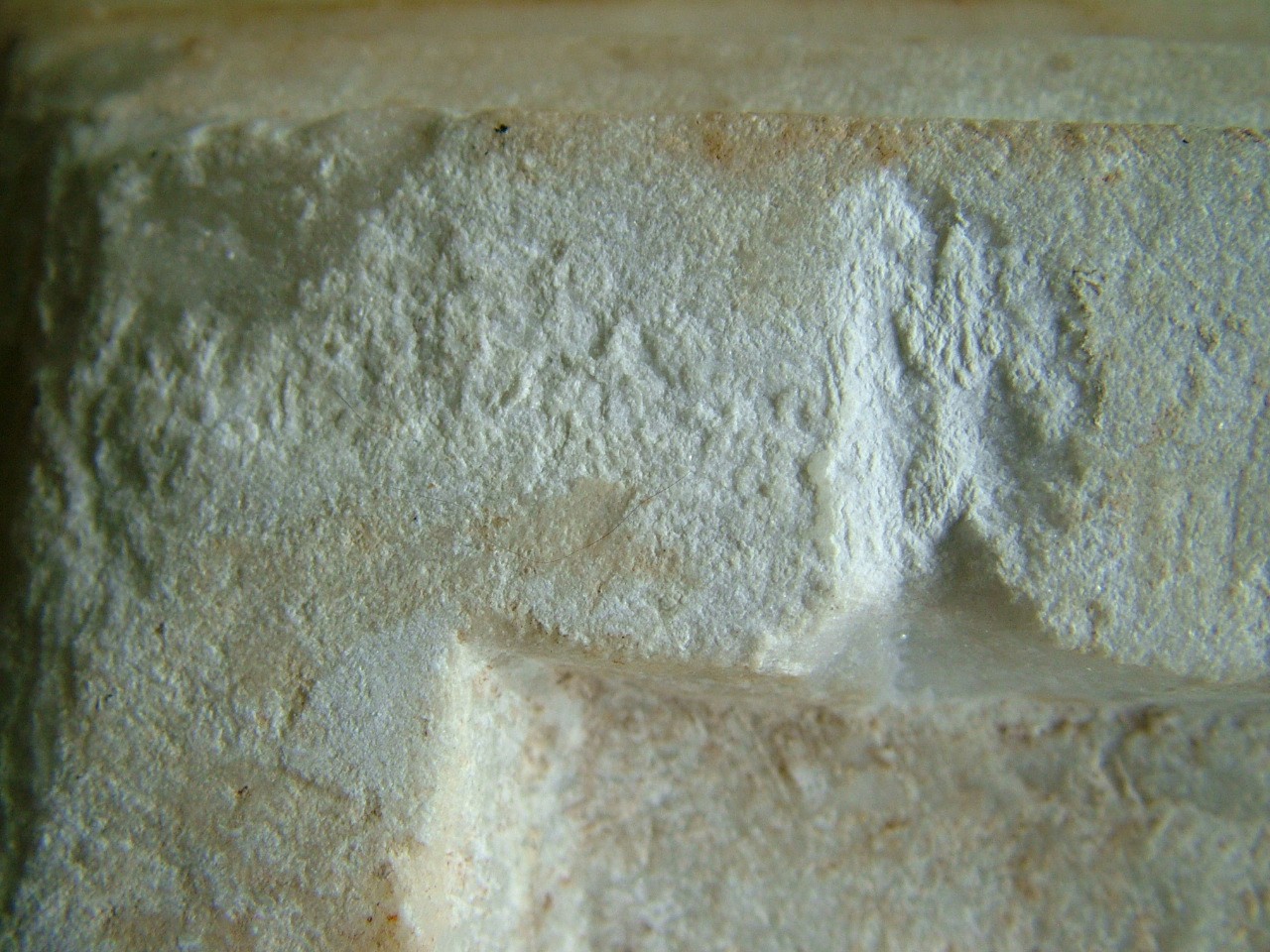 |
|---|
CINERARY TOP OF A STANDARD BEARER OF LEGION I ADIUTRIX |
|
| Picture Group 1 |
|
| THE INFORMATION WITH THIS ARTIFACT IS CURRENTLY BEING UPDATED. This is a Marble Cinerary Top (or Lid) of the Neronian or Flavian periods, it appears to have been scrubbed, besides any damage done in antiquity (the damage appears to have been purposely done for mementos) it has one ding on the center top (just over the eagle) that "may" have been done in the last hundred years or so. The theme on this is the Aquila (Eagle) of Legion I Adutrix, it was made for a Standard Bearer of that legion who had previously been a Classari (Marine) of Classis Pontica and Classis Misenum, an inscription and art in resin mixed with paint shows that while serving in that capacity as an auxiliary that he had served in the First Jewish-Roman War. With this there is a reference to Nero, Vespasian, the Battle on Lake Tiberius, the New Age of Pieces, and strangely the conquest of Christian symbols. This cinerary top came with a Cinerary Box, the box is of the mid 1st C. AD and is of a slightly smaller size, it is of a slightly different type of marble, more worn, and has a faint yellow patina. The box at a glance shows a relief on the front of Pope Benedict XIII (born Pietro Francesco Orsini, but renamed Vincenzo Maria Orsini), this was carved in the 19th C. AD, but there is more to this. The inside of the box has an Arthurian theme that among other things includes a sword in the stone motif and a bear spewing from the mouth of a volcano, this was done in the 19th C. AD. There are two small bits of embedded iron on the top edges on each side of the box. There are 18th to 19th C. AD inscriptions and art on and around these, they are of Christian and legendary/mythological themes. The bottom of the box shows an Arthurian theme connected to an active volcano, it is also of the 18th to 19th C. Although the box appears to have been in the 18th C. AD of Pope Benedict XIII, the work or rework of the Arthurian symbolism appears to have been made by or for a group of Carbonari (19th C. AD Italian revolutionaries of the il Risorgimento) who were Gnostics and the Carbonari leader Felice Orsini ( who attempted to assassinate Napoleon III in 1858). There is evidence that the inscriptions and art in resin on the top on the flat of the right side had been deciphered correctly by who ever put the top and box together, the reason is that they are of the dawning of the New Age of Pieces during the reign of Nero and Vespasian, the placing of the top with it's engraved eagle appears to have been viewed in the as symbolic of the dawning of a New Age of Aquarius, that is either at some time during that 18th to 19 C. AD period or at some time in the future, either way the name Orsini is attached to that dawning. The name Orsini is thought to be derived from the word Ursa that is German for bear, the Orsini family were one of the two most powerful Italian family's during medieval times and the renaissance. Legend has it that they were descended from the Julio-Claudian family of ancient Rome, the last of the Julio-Claudian emperors was Nero. Pope Benedict XIII was of that family, but currently I have found no evidence that would suggest that Felice Orsini had also been of that family. If you would like to read more on the box itself, then go to the bottom of the page.
Both the cinerary box and top had been authenticated by a major international auction house as a "circa Late 1st C. Marble Cinerary Urn and Lid with a bizarre 18th to 19th C. relief of a Pope on the front panel". The box and top were being scheduled for an auction when I was contacted for further authentication by a noted international architectural designer and historical preservationist in Sept. 2003, they were purchased at that time. They were part of an inheritance from his family's art collection and had been brought to America from Rome, Italy in 1938. This cinerary top shows a splayed eagle in relief between a sculpted long haired head on each end, under the eagle are serpentine waves and a suggestion of at least two dolphins. The eagle and the waves/serpents/dolphins appears to have been done by a different craftsman. Although perhaps not originally, the two heads "may" have later been associated with the twin brothers Castor and Pollux as the Dioscuri, that is even though the Dioscuri are usually seen wearing pilus hats. The Dioscuri were especially sacred to ancient sailors and Roman horsemen, they were also symbolic of St. Elmo's fire. To my knowledge eagles on Roman cinerary's are rare but not unheard of, those that I have seen are usually of eagles that have closed wings, this is the only example of a fully splayed eagle that I have seen to date. The miniature art on the eagle and a Vexillum (a square or rectangular legionary flag standard on a pole draped from a short cross bar ) carved in a graffiti style underneath the cinerary top shows that the reason for the splayed eagle is that it is of the Aquila (Eagle) of Legion I Adiutrix. There are suggestions that the cinerary had been made for the funerary urn of an Immune (that may have been a scribe or courier that had something to do with building or engineering) who was a Classarius (Marine) of the Classis Misenium (Fleet at Misenium) who had become a Standard Bearer for Legion I Adiutrix, it is possible that he may have been that legion's Aquilifer (Eagle Bearer). The Aquila (Eagle Standard) of I Adiutrix was unique in that it was the only eagle standard that had been fought for. This took place during the year of the four emperors when Galba was met at the Milvian Bridge by members of this newly formed legion demanding their eagle (besides the symbolism this also meant their citizenship, additional pay, and benefits). The first legionaries of Legion I Adiutrix were recruited from the ranks of the Milites Classiarii (Marines) or the Classiarii and Milites Nauclarii (Sailors) from the Classis Misenensis ("Fleet of Misenum"), they were thought to have been formed under Nero. Galba's legionaries attacked and disbursed the petitioners, many were killed, but then shortly after Galba awarded Legion I Adiutrix with it's Eagle. Pictures 1 thru 12 shows the details of the front of the cinerary top. Pictures 13 thru 24 shows this area upside down, specifically with pictures 13,14, and pictures 19 thru 22 there is the sea god Triton or one of the Tritones.. Pictures 25 thru 27 shows on the eagle's head a lance, a dolphin on a short pole, a trident, a laurel or palm, the letters "CS" that are also the letters "CSS", and a laurel. The letters can also be seen as "CS", "GC", and "SSG", most likely it stands for the Emperor Servius Sulpicius Galba as a Caesar, but the "GC" could be for Julius Caesar or Octavian, or both of those men. There is a suggestion with the symbols of an arm with a hand holding a trident and also a face with a dolphin helmet. These symbols along with the Triton or one of the Tritones should represent standards of the Classis Misenensis, but even more so the standards of the Classiarii of Misenum. My research shows that the abbreviated letters "CSS" usually stands for the Classiarii (Marines) and to a lesser degree the Classis (Fleet) itself. There are indicators with this that the primary weapon of the Roman Marines had been the lance, that the helmets of the Marines at Misenum may have been decorated with a dolphin motif; and that shields may have been decorated with an arm, hand, trident with a single laurel or palm to the right. According to Virgil's Aeneid Misenum was named after Misenus who while in Troy had been Hector's comrade in arms but later became the trumpeter to Aeneas (the legendary founder of the Roman race). Misenus was drowned near Misenum by Triton after challenging the gods to a trumpet competition. When Misenus's body washed ashore the Cumaean Sibyl told Aeneas that his body had to be buried before he could enter the Underworld. |
|
| Picture Group 2 |
|
| This group of pictures is of the details on the eagle. The eagle's breast has a face facing to the right. Also on the eagle's breast there are the bind letters "ELISIVM" (Elysium), these can also be seen as "MISENVM" (Misenum). In Virgil's Aeneid Aeneas was led to the Underworld by the Cumean Sybil through a cave near Lake Avernus (that was part of Portus Julius, the Naval base at Misenum), his final otherworldly destination was Elysium, but then Aeneas was allowed to return to the world in order to found the Roman race at Alba Longa. At another angle it can even be seen in reverse as "MSO", this may suggest disguised initials of the second emperor in the year of the four emperors "Marcus Salvius Otho".* On the wings there is a dragon wind sock facing to the right, it is made of rope, research shows that any Roman rope motif is usually associated with the Roman Navy or Cavalry. The windsock also hints of a ballista bolt and, or a comet; if so the according to the orientation of this cinerary top it is in an easterly direction. The eagle's talons on the left are in the shape of an "A", the talons on the right are in the shape of a "D" and an "X", this should stand for Adiutrix. The eagle's leg and talons to the right are in the shape of a bearded head in a pointed helmet and a goat's head in a pointed hat. There are also the letters "AL" (most likely for an abbreviation for the Roman word for white Alba, perhaps for Alba Longa), but yet these letters can also be seen as an "R", the "D" can also be seen as an "O". If this is put with the "X", then it becomes "ROX". This may be for an Ala of the Sarmatian tribe the Roxolani, but more particularly it may be a symbol of the East. Overall this area also hints of an evergreen tree. Between the eagles legs there is a large face that may be a type of otherworldly sun. The eagle's tail is shaped like a water gutter, but yet it also shaped like the top part of a lance in a gutter, if so then the lance is sticking in the throat of the large head on the eagle's breast. The eagle's wings are curled at the tips like waves, this could suggest that the original Aquila (Eagle) of I Adiutrix may have had these same type of wings. *The I Adiutrix fought valiantly for Otho in it's first action as a legion at the First Battle of Cremona and briefly captured the Aquila of the XXI Rapax, but the battle was lost to Vitellius's (the third emperor in the year of the four emperors) forces. There was a chance for ultimate victory as relief legions were nearby (this included Legion III Gallica). In order to avoid the further spilling of Roman blood Otho selflessly killed himself with a dagger (choosing one of two daggers). His body was carried by his Praetorians and cremated on a pyre, but then something very strange happened. That is some of his soldiers killed themselves next to the pyre and soldiers in other camps followed suit. Such strange behavior is more like a Steppe Chieftain's or an Eastern Asiatic Ruler's funeral rite, it is completely un-Roman. What "may" be the answer to this is that Tacitus records that in March of 69 AD that Otho celebrated a Victory over the Rhoxolani in Moesia. The victory was attained by the III Gallica, Otho was not at the battle. Otho was known to have a keen interest in foreign religious cults. Needless to say there are hints of a torch, two Asiatic type knives, and an Asiatic type sheath on the eagle's wing to the right. So if the Roxolani are mentioned on the eagle's leg and talons, then combined with the dragon windsock it may suggests that stories of a Rhoxolani Chieftain's funeral rites had left an impression on some legionaries. There is one more speculation with this theory, that is that at the Second Battle of Cremona Legion III Gallica faced the East and the rising sun just prior to the battle. This unusual behavior has theorized by some to be connected to a solar rite of the soldierly mystery god Mithra, maybe, but maybe not. The result of that battle was that Vespasian the fourth and final emperor in the year of the four emperors defeated Vitellius. Vespasian had been a staunch supporter of Otho and supposedly had received a message from Otho just after the First Battle of Cremona that he was to avenge his death. The legionaries of the III Gallica facing the sun in the East may have been practicing an unknown rite of the Rhoxolani in connection to a spiritual resurrection of a leader. Vespasian was seen at that time by many Romans as the ultimate savior figure, he went on to became one of Rome's finest emperors, if not the finest.
|
|
| Picture Group 3 |
|
| This group of pictures is again of the eagle, but they were taken under different natural lighting conditions, there is also a focus on the eagle's beak. Among other things the eagle's beak has linear devouring animals and animals with human type faces that are on top of it (this is somewhat similar as to what is seen with the art of the Steppes), the beak is also a talon and, or a fang. Some of the animals may be, an otter, a seal, and a bear. According to my research all this suggests that these are symbols of magnetic north and the water compass. It shows that the eagle is oriented to the North, such as this cinerary top would have been. |
|
| Picture Group 4 |
|
| This group of pictures shows the details of the rest of the top of the cinerary top. Although it is faint there is a long standard pole and spear or lance head that goes around the cinerary from the right, to the front and to the left side. Due to this it can be speculated that the Classarii of Misenum and the I Adiutrix may have had a vertical sea serpent or serpents painted on their standard poles. This is important as the spear head or lance head is exactly where it should be with the white vexillum seen on the underneath in Pictures 4 thru 7 with Picture Group 7. Although there is not enough contrast with these pictures to be seen completely, the entire artifact has; small carvings, worked cement, various pastes, various paints, resins, remenants of wax, and even a few specks of wool in resin. It appears that this had been done by family members and friends of the legionary, although with any family members it most likely had been done over generations. This is also seen with artifacts that have had breakage in antiquity but were still used, this is type of art over breakage or with holes is typical from what I have observed on countless ancient artifacts, it is even more so with anything used for funerary purposes. More of the details of this can be seen in the next group of pictures. |
|
| Picture Group 5 |
|
| This group of pictures shows the details of two small pieces of art that were applied to the cinerary top. The first piece is made of specks of textile and a speck of white wool, it appears to have been soaked in resin and then worked. The speck of white wool is 2.2 mm in length. It shows a spectre type figure in long beard. Pictures 9 thru 21 shows the second piece in the four directions, it is located just under the rim in front, it is made of resin and paint. In the first direction with Pictures with 9 thru 11 it shows a figure with a tail, on this are the bind letters that can read "MISENO", but they can also read "NERO", this should mean Nero at or connected to Misenum. In the second direction Pictures 12 thru 14 shows various small figures and what may be the bind letters "ELISIVM" (Elysium). The third direction with Pictures 15 thru 17 shows a figure in a helmet behind what may be a pig or a boar, the figure in the helmet has the letters "H", "R", and "I". This should have something to do with Rome's Imperator (Emperor). The fourth direction with Pictures 18 thru 21 shows a head in a large bird's head with an open beak, this is also a large letter "F" with the smaller letters "SC" on the bird's head. This should be the goddess of fidelity Fides as an oath to the Roman Senate, but also Nero. When the symbolism with the second piece is put together it should read an oath of fidelity to the Emperor Nero and the Roman Senate. As mentioned previously the I Adiutrix was formed from the Classiarii or the Classiarii and Nauclarii from the Classis Misenium and that Nero is thought to have initiated their formation. |
|
| Picture Group 6 |
|
| This group of pictures is of the cinerary top's back. This has a large faded painted theme that shows large sea creature's and a few child's faces. Upside down it shows figures in some type of conflict or struggle. According to other 1st C. AD Roman artifacts all this may be taking place in the North Sea. My research with those artifacts suggests that the Romans were aware of and highly interested in the North Sea from at least the time of Julius Caesar onwards. It appears to have been for both legendary/mythological and strategic reasons. This interest appears to have peaked during the reign of Claudius, the Flavians, Commodus, perhaps during the Triarchy, and in the reign of Constantine I. |
|
| Picture Group 7 |
|
| This group of pictures is of the inside of the cinerary top, most of the technique to decorate this was by carving and with gypsum. There are three small areas that have earth mixed with resins and other materials, the two largest of these areas are highly important as they seem to represent the location of Elysium as the Canary Islands, there may even be more with this. The first three pictures show a rectangle flag, according to images on artifacts this was a type of flag standard along with various pennants was used by the Roman Cavalry and the Roman Navy when in motion (as well with certain Northern Germanic tribes), it is not seen with the legions. This is the primary position where the engraved eagle is on top, so the position of the side to the right is East and the position of the side that is to the left is West. The inside of this is carved with many figures and symbols that will transform when moved, as it is white it is difficult to see these in photographs. What can not be seen in these pictures is that the flag is also an open scroll and some what like a legionary diploma. Pictures 4 thru 7 shows the cinerary top's inside when it is seen on one of it's sides. In this position the flag is seen as a Vexillum with a bottom fringe, in it's original position when the eagle is oriented to the North, the vexillum's top is pointed to the West.* Inside this near the top are two areas with earth and resin art. Pictures 8 thru 14 shows that there is a white on white spectra figure. Under the figure there is a large letter "A". The "A" in different positions can be seen as a "D", an "I", a "V", an "R", and an "X'. It should stand for the word Adiutrix. There may be are hints of one of, or some of, or all of the following; an anchor, a lance, a plum bob, a carpenters compass, a carpenters square, and a scythe. Pictures 18 thru 22 show the largest area with the earth and resin. It has various pastes, an engraved sliver of ivory, and an inscribed micro bit of onyx or obsidian that is rectangular in shape. Overall this area is shaped like a dog's head. In connection to what will be seen with the next group of pictures; the fact that the vexillum's top as a flag faces to the West when in the primary position, the fact that the ancient Greek writers thought that the Elysian Fields (Roman Elysium) were located on one of the Canary Islands, then his may be the volcanic Island of Canaria (modern day Tenerife) of the present day Canary islands that was described by Pliny the Elder in his Natural History (written from 77 to 79 AD). It was named Canaria for the large dogs that supposedly inhabited that island, Cani or Canis is the Roman word for dog. Pictures 23 thru 25 shows the next largest piece of earth and resin art. It may be another island of the Canaries, if so then due to it's shape it the location then it is most likely the island that is modern day Gran Canaria. Pictures 26 and 27 shows the same area in a different position, it hints of a slightly distorted face, if so then it may be what the Romans thought the Guanches (indigenous people of Tenerife) at that time looked like. Pictures 28 thru 33 shows details of the vexillum's bottom fringe. The Fleet at Misenum had the coast of Egypt and the Mediterranean west of the Italian peninsular as their main areas of operation. Due to archeological finds of the last decade or so it is now pretty much accepted that the Romans knew about and used the Canary Islands, it can be expected that those islands were part of Misenum's lore. Of note is that there is an active volcano on the Mt. Teide on Tenerife in the Canary Islands. My research with images on artifacts shows that the Romans thought that all volcanoes were connected by underground lava streams, and that Vulcan could at times take on the role of a mobile god. Therefore it is quite possible that the Romans thought that Mt. Teide had been connected to Mt. Vesuvius as well as any other known volcanoes. The I Adiutrix was in fact briefly stationed in Hispania in 70 AD. Immediately after the First Battle of Cremona the I Adiutrix was transferred to Hispania, shortly after they were transferred to Germania, then later to Pannonia. They fought in Germania, Pannonia, Dacia, and various campaigns in the East. The legion existed well into the 5th C. AD. * Although the national flag draped coffin of deceased members of the military is derived from the French during the Napoleonic Wars, the position of the Vexillum seen here suggests that there may have been a Roman president for the same, it suggests that at least in some instances that a white Vexillum had been placed over the body or remains of a deceased Roman soldier, it may have originated from an even more ancient tradition, perhaps from a sea or river people. The symbolism with this may be that the Vexillum was also seen as the sail of a ship that carried the heroic to Elysium or another honored place in the other world. |
|
| Picture Group 8 |
|
| This group of pictures is of the same area as the last group of pictures, but in different positions. Pictures 1 thru 9 shows the second largest piece of earth and resin art as a stern face that with other engravings is part of figure, the figure wears a tall elaborate headdress. There is a bright area in front of this, it is as if the figure is taking in the bright white, this suggests the receiving of a spirit. Over the figure are the large letters "PL" and "PE", and a smaller "EL". This should be abbreviations for Pluto the Roman god of the dead and his wife Proserpina (the daughter of Ceres) as the rulers of Elysium. Pictures 12 thru 34 shows various details of photos taken with different natural lighting conditions. Pictures 25 thru 38 shows a painted figure with smaller figures, it may be of or connected to the legionary who this was made for. |
|
| Picture Group 9 |
|
| This group of pictures shows various areas of miniature art on the underside of the cinerary top. A few of these areas are also seen with other picture groups, but they are either in different positions or with different natural lighting conditions. Pictures 8 thru 15 shows the third area of earth and resin, it is much smaller then the other two examples and is on the other side of the underside. I currently do not have any speculations as to it's overall meaning. Some of the art seen here gives a bit of an idea of how much of it is white on white, therefore difficult to obtain images with enough contrast. THE SARMATIAN CHRISTIAN CONNECTION Click Here! ROMAN MID-1ST C. AD / ARTHURIAN 18TH C. AD CINERARY BOX Click Here! CINERARY BOX INFO:Copyright 2010 David Xavier Kenney |
|

